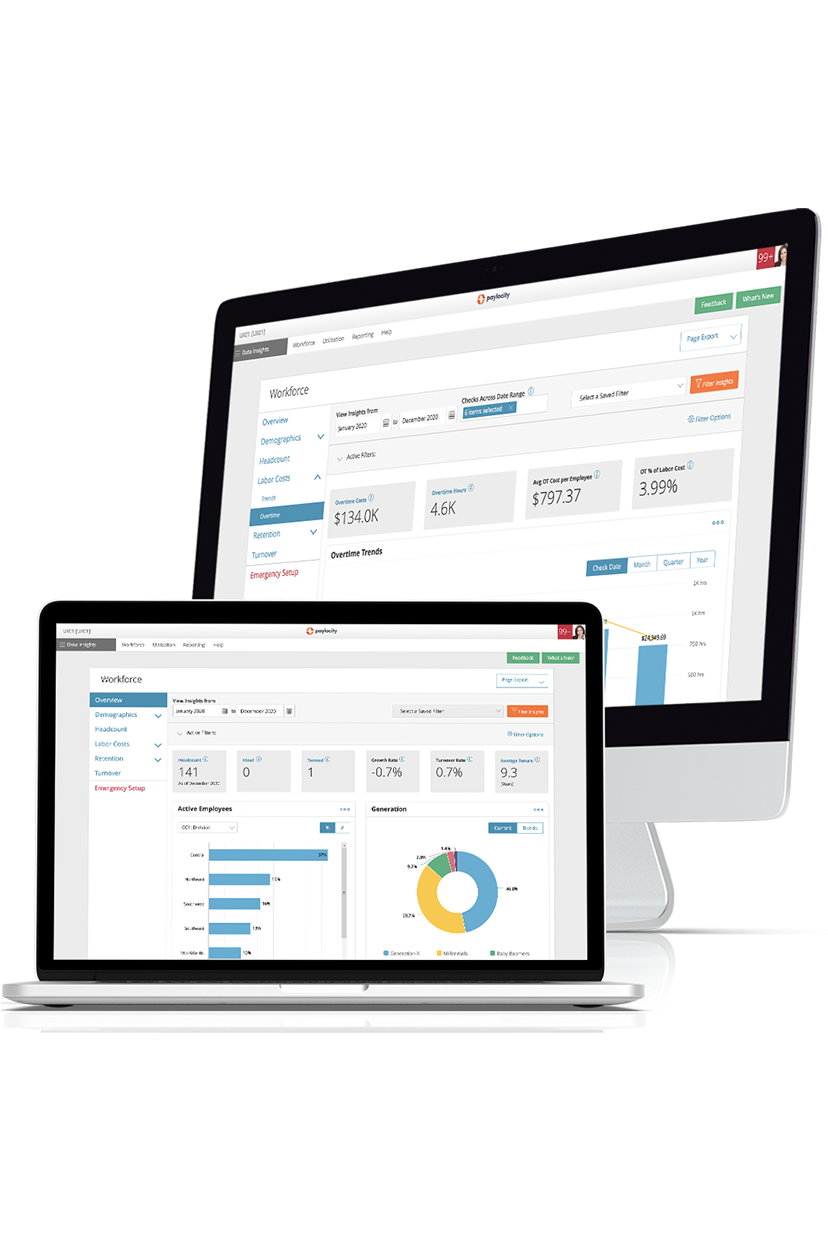resources
10 HR Metrics That Matter to Your C-Suite
March 24, 2023
Human resources metrics guide decision-making every day for HR professionals. But when it comes to taking your data to the C-suite, it’s vital to present the HR metrics they care about.
Blog Post

As an HR professional, you could spend hours looking at data to help guide your next big decision. But when it’s time to present to your company leadership, it’s helpful to know your audience.
Go into your next meeting confident with the knowledge of the top 10 HR metrics that matter most to your C-suite.
What Are HR Metrics?
HR metrics are key data points that help companies evaluate their human capital efforts and determine the effectiveness of their HR programs and initiatives. Employee attrition, benefits participation, employee engagement, cost per hire, and more are examples of critical HR metrics.
Why are HR Metrics Important?
The use of human resource data has become a key component of making workplaces better in the past few years.
In today’s challenging labor market, where 74% of companies are underperforming in their recruiting efforts, companies use the vital insights provided by HR statistics and metrics to measure which programs are working well—and which ones could use improvement. Plus, they empower organizations to make informed workforce decisions.
Reporting and tracking HR metrics helps organizations use data to make strategic plans for the future by:
- Finding ways to improve the effectiveness of your HR programs and initiatives
- Quantifying the cost of HR processes so you can increase efficiencies and minimize expenses to improve ROI
- Ensuring you’re making the most of your labor resources by helping employees maximize performance and productivity
- Measuring employee engagement, and leveraging data to develop informed strategies for improving satisfaction and retention
- Comparing the performance of HR initiatives with targets and objectives to make adjustments as needed
- Predicting the results of any proposed changes to policies, benefits, schedules, and organization structure
Examples of Where to Use HR Metrics
HR metrics are used across the whole spectrum of human capital management, helping you to assess the many different processes within HR.
Recruitment
Use HR metrics to check the efficacy of your recruitment process, and assess specific campaigns. How many people apply per vacancy? Which recruitment platforms work best? Are your salaries in line with industry standards?
If you’re planning to take on new hires, or recruit globally, check the metrics before going ahead. Look at cost per hire and time to hire, but also at how you can improve the candidate experience.
Training and Development
These metrics include how long training takes, how much it costs, and whether it’s effective. Employee performance is an indicator, but feedback is also important—do staff feel supported? Do they have sufficient development opportunities?
If you spot problems, you might decide to invest in more user-friendly software, introduce peer-to-peer mentoring, or develop tailored training content.
Attrition and Retention
Metrics like turnover rate and average employee tenure will show you if there’s a problem with retention, giving you the chance to investigate. Carry out exit interviews and surveys, and measure current engagement rates.
HR analytics can also identify those who are at risk of leaving the company. You can then get working on employee engagement ideas.
Key HR Metrics That Matter
When it comes to using HR metrics to influence recruitment and retention efforts, it’s critical to track the effectiveness of your HR initiatives throughout every stage of the employee lifecycle.
This means starting with data points like time to fill and cost per hire. It also involves evaluating turnover rate, measuring performance and promotion rates, and examining the programs that can impact the employee experience, including diversity and inclusion, utilization, engagement, and pay equity.
While there's a near endless number of data points you can analyze, we recommend these 10 high-level metrics as among the most effective for engaging the C-Suite and surfacing the most consequential issues.
1. Employee Turnover and Retention Rates
When your employees leave, your company takes a hit – in both finances and morale. In fact, each departure costs about one-third of that worker’s annual earnings. And when turnover is high, these expenses can add up to an expensive your C-suite notices.
Keep an eye on employee retention rate in conjunction with turnover rate. While these two HR metrics examine opposite behaviors, both provide valuable insight into employee satisfaction and problems throughout the employee lifecycle that may cause workers to leave.
Start looking beyond – and before – the exit interview to find the root cause of employee turnover. A modern workforce solution can utilize HR reporting software derived from employee metrics to help you predict trends and flag employees at-risk of departure.
Learn More: How to Calculate (And Analyze) Employee Turnover Rate
2. First-Year Turnover Rate
Losing an employee at any time can be a challenge. But consistently losing employees during their first year of employment is a red flag. Early turnover rate can especially impact your employer brand, recruitment budget, and team balance.
One-third of newly hired employees quit within their first year. Considering the money, time, and resources it takes an employee to settle into a position, your return on investment quickly diminishes if your first-year turnover rate isn’t under control.
Use tools like HR onboarding software and learning management systems to ensure new hires get the support they need during their critical transition period.
3. Cost Per Hire
As you look to replace your open roles with top recruits, bring a thorough estimate of your cost per hire to your company leadership.
Knowing your line-item expenses including internal and external costs, salaries, and total number of hires during a set period can inform employee recruitment decisions, and help you plan ahead when it’s time to evaluate employee performance to see how your investment has truly panned out.
4. Time to Hire and Time to Fill Open Positions
On average, it currently takes 36 days to fill an open role. But considering most good candidates are off the market within 10 days, it’s critical to hone both your time to fill and time to hire processes to as small a window as possible.
While time to hire and time to fill are sometimes used interchangeably, there are key differences between these two HR KPIs:
- Time to Fill refers to the time required for the entire hiring process, from creating the job opening to the time a candidate accepts the role.
- Time to Hire begins the moment a candidate enters the pipeline and ends at the time they accept the job. Time to hire reflects the efficiency of your recruiting process and time to fill reflects the efficiency of your organizational hiring process.
The longer a position stays open, the more money you spend on job board listings, your current employees taking time to interview and cover tasks, and your own team sifting through resumes.
Employing a recruitment dashboard backed by an all-in-one modern workforce solution gives you a bird’s-eye-view of your reach while collecting and evaluating data.
5. Diversity, Equity, Inclusion, and Accessibility (DEI&A)
Do your employees feel Ied? The value of diversity, equity, inclusion, and accessibility (DEI&A) in the workplace not only makes good people sense but business sense, too. Diversity, equity, inclusion, and accessibility strategies are no longer “nice to have.” Candidates, employees, and clients make decisions on who to work for and with based on these strategies.
In fact, according to a Deloitte survey, “94% of executives and 88% of employees believe a distinct workplace culture is important to business success.”
By looking at your company’s company demographics, and gathering people metrics, you can empower your C-suite to make sound, data-based decisions rooted in a progressive strategy to remain competitive.
6. Pay Equity
A rising trend in HR is pay transparency, also known as pay equity – with some states already making this trend into law. As your company prepares to align with equity in the workplace, make sure you don’t have pay discrepancies that could highlight gaps due to gender identity, race, or other reasons.
Diving into your payroll metrics beforehand to analyze where you need to adjust helps you solve pay equity issues and get back on track with your overall diversity and inclusion goals.
7. Employee Performance Metrics
When it comes to performance reviews, your company leadership looks at the big picture. How are employees performing overall? Are teams measuring up to their goals? How can data analytics improve the measurement of employees' performance?
Naturally, it'd make sense to look at a metric like percentage of performance goals met or exceeded and call it a day — but you also want to make sure HR metrics like these are accurate.
Because most companies only do performance reviews once a year, goals can massively change due to reasons beyond the employees’ control — leaving 95% of employees feeling dissatisfied with their company's appraisal process, and 90% believing the process provides inaccurate information.
Don’t dust off performance reviews once a year. Instead, reviews a continuous process for both managers and employees, employing 360-degree feedback. Use a performance management tool that includes review and self-evaluation capabilities, to consistently monitor feedback and course-correct as needed.
Another tactic to track performance is through goal tracking and training completion within an HRIS. Many learning management systems (LMS) provide data points on how employees engage with mandatory and optional training. These HR metrics allow managers to see where workers are for learning and development targets, and where they could use support.
8. Internal Promotion Rate
Successful employee development not only leads to job satisfaction and retention, but can also lead to an increased internal promotion rate when top performers continue to grow.
Employees – and managers – who are committed to high achievement can use a modern workforce solution and monitor progress with tracking linked directly to each employee record via an LMS.
A continuous, on-the-go learning experience with the ability to incorporate peer-to-peer options could lead to a much more effective training program and a higher internal promotion rate.
9. HR Software Utilization
The C-suite cares deeply about the bottom line. If you’re using an HCM solution, are you getting the biggest bang for your buck by maximizing adoption and utilization?
Look at how your employees are — or aren’t — using it. If they aren’t, it could be a sign that there’s an issue with poor experience or feature availability. A good, all-in-one HCM suite will highlight these key HR metrics and guide you on the best steps to improve the employee experience.
10. Employee Satisfaction
When you think about employee engagement, your mind might not gravitate to the hard numbers. But when people like their jobs, are proud to do it, and are more engaged, they’re likely to deliver on their goals and stay longer.
Encourage an environment of open dialogue, where employees know their voices are heard. An employee survey tool for new hire check-ins, employee satisfaction, stay interviews, and exit analysis can help measure employee sentiment, opening the door for continuous feedback and improvement.
Redefine your Strategy with an HR Metrics Dashboard
Find the sweet spot between the data and your people. Use these HR metrics to help paint a picture for your C-suite of the full scope and help move the needle forward. Monitoring HR KPIs is critical for building business cases and data-driven strategies.
As Josh Bersin puts it, “In a diverse world of workers, companies have to diversify their sourcing, create a holistic employment brand, prioritize internal mobility, simplify the candidate experience, and use AI and technology strategically.”
The good news? This is more than possible with the actionable HR metrics and strategic direction provided by data driven insights. With the right HR suite, you can easily identify trends, pain points, and determine the business impact of the challenges facing your workforce. HR KPI dashboards will help you continually monitor these key data points, so you can be proactive instead of reactive.
If you need assistance with finding a modern workforce solution that creates HR dashboards to visualize key performance indicators (KPIs), analytics reports, and much more, request a demo with Paylocity. We partner with you right from the start to ensure your HR KPIs and departmental priorities are met today and you’re set up for future success.

Make Data Work for You
Are you still relying on instincts or assumptions to help you make decisions? Your workforce is changing fast. It’s time for a better approach. With a real-time, easy-to-understand analytics dashboard, you can see what’s really going on in your company and make smart moves based on data. Share insights and results quickly with tailored reporting, and get to know your employees better to improve your overall experience.


